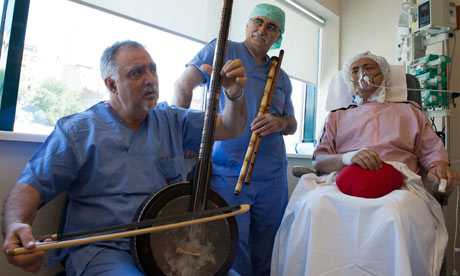Istanbul hospital revives complementary therapy for a range of illnesses by playing ancient Arabesque scales and patterns
Constanze Letsch in Istanbul

Anaesthetist Dr Erol Can (left), playing a yayli tanbur, an Ottoman violin with Professor Bingur Sönmez holding a flute. Doctors in the Istanbul hospital are reviving ancient musical therapy for a variety of illnesses. Photograph: Jonathan Lewis
Mahur makam – a rousing music mode, used as treatment for depression Link to this audio
Standing by the bed of a Cypriot patient who has just undergone vascular surgery, Dr Bingür Sönmez consults a screen monitoring pulse and blood pressure.
Then a colleague pulls out a flute and starts playing a popular Turkish tune.
If that appears an unusual approach to modern medicine, then it is. But according to doctors at the reassuringly modern Memorial hospital in Istanbul, it is producing results.
Here, Sönmez and his colleague, Dr Erol Can, are reviving traditional Islamic music therapy, a form of medical treatment that is almost 1,000 years old.
And they are convinced that, if used as a complementary therapy, ancient Arabesque scales and modes can produce significant psychological and physiological outcomes.
Can, chief anaesthetist in the intensive care unit of the department, says that he discovered music therapy when he worked in a Sofia hospital in his native Bulgaria.
Hicaz makam – beneficial when dieting Link to this audio
“Back then I used a tape recorder and headphones.” When he emigrated to Turkey in 1996, he gradually started to replace recorded music with live instruments.
Segah makam – to help the patient relax and help against insomnia and sleeping disorders Link to this audio
“I learned to play the ney flute in order to play the kind of music that was used in traditional music therapy hundreds of years ago, making use of the psychological and physiological effects of the makam.”
The makam – from the Arab word maqam – is a musical mode unique to classic Arabic and Turkish music. It defines the pitches, patterns and development of a musical piece. The term refers to a very wide variety of different tone scales that must be largely learned by ear.
Saba makam – for meditation Link to this audio
“There is a different makam for every illness, every health problem,” Sönmez says. “There are makamlar that agitate, and there are makamlar that relax.” Playing a few notes on his ney, Can adds: “The so-called rast makami has a positive effect if a patient suffers from anorexia, whereas the hicaz makami should be played if a patient needs to be kept on a diet.”
He laughs. “A restaurant that plays music in the hicaz mode would probably go out of business after a while, because it keeps customers from eating!”
“We are not doing anything new, and we are not reinventing the wheel,” Sönmez says with a shrug. “The positive effects of music therapy have been known for well over 900 years.”
The use of makam was integrated into medieval Islamic medicine as early as the 9th century, when scholar and philosopher Al Farabi discussed and catalogued the effect of different musical modes on body and psyche.
As Can plays Akdeniz Geceleri, a popular Turkish song, to the Cypriot patient, she tries gently to sing along, visibly relaxing.
Sönmez stresses that music is no substitute for conventional medical treatment. “We don’t use music as an alternative to modern medical methods”, he says. “It’s complementary treatment. Without having to prescribe additional drugs, five to 10 minutes of a certain musical piece lowers the heart rate and blood pressure.
“Medieval hospitals were built around a courtyard with a fountain. The sound of the water, the colours of glass windows, the intensity of the light, the types of flowers and plants – all of it was part of the complementary treatment of patients,” Sönmez explains. “We are thinking of changing the light in the intensive care unit to pink,” he adds with a smile. “Pink light has a soothing effect.”
There are signs that the medical pipers may inspire others to follow suit. “We have been using makam for five years in our department,” Can says.
“Now colleagues started to consult us, a surgeon from the paediatric ward now takes ney lessons from me.
“And sometimes, we play for our colleagues who are on a break. That way, everybody is cared for.”
via Turkish doctors call the tune with traditional musical cures | World news | The Guardian.

Leave a Reply